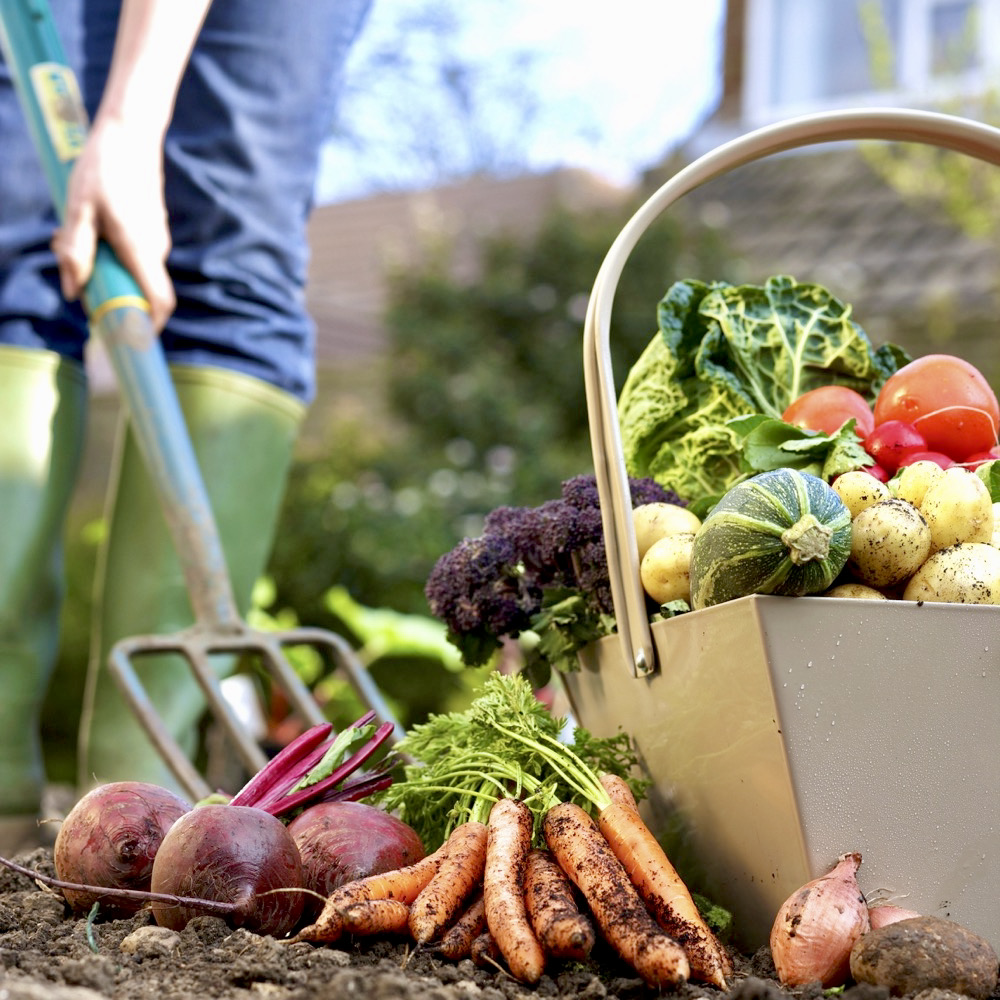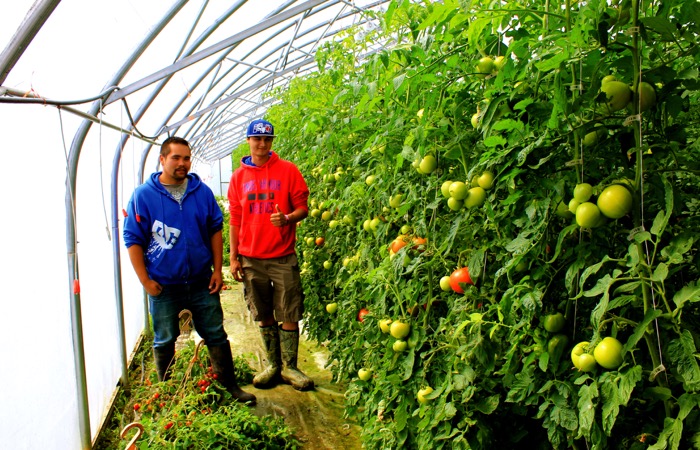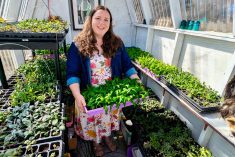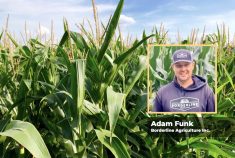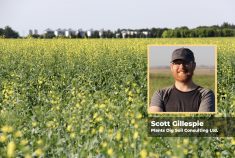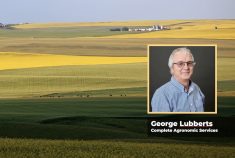Wally Satzewich learned from his mother at an early age how to pull weeds and tend a garden, and was grateful for those skills when he started his own urban agriculture project many years later. His parents were first-generation Ukrainian immigrants who had come to Canada in the early 1950s and settled in Saskatoon, where he was born in 1958. His dad had his own small butcher shop, while his mother, who came from an agricultural background, was an avid gardener.
First though, Satzewich went to university where he studied sociology for three years before realizing it wasn’t the best road for him. Then he set up a taxi franchise in Saskatoon, which he ran for 10 years, all the while shopping at the local farmer’s market every Saturday, and beginning to formulate an idea to try market gardening.
“But it never materialized as an actual possibility until our family bought an acreage just outside of Saskatoon in the mid-’80s,” Satzewich says. “We dabbled as a family. Back then it was a self-sufficiency thing. I experimented with small-scale farming and entered the farmers market in 1991, and then transitioned from full-time cab driving to full-time market gardening during the early 1990s.”
Read Also

Agronomists share tips for evaluating new crop products and tech: Pt. 3
With new products, new production practices and new technology converging on the agriculture industry at a frenetic pace in recent…
After a few years, Satzewich met his future wife, Gail Vandersteen, who was a regular customer at the farmers market. Vandersteen, who grew up on a farm in the Interlake region of Manitoba, was working as a library technician at the University of Saskatchewan at the time, but the couple decided they wanted to expand the small farming operation that Satzewich had started, and so they moved their market garden site to a location about 40 minutes from the city, close to the South Saskatchewan River where they eventually grew 20 acres of irrigated vegetables.
After five years, the couple realized this model of agriculture wasn’t working for them. It was too big to manage themselves, and they didn’t want to have the headache of trying to hire and manage people to help with the work, so they sold the land and gardened entirely in the city, where they had been experimenting with growing crops like radishes, green onions and salad mix — their most profitable crops because they could sell them locally — on small plots of land.
“We knew what we could grow in the city successfully, and we started accumulating more garden plots,” Satzewich says. “Once people got to know what we were doing, they enthusiastically offered garden plots to us. At our peak we were managing about 30 garden plots.”
SPIN (Small Plot Intensive Farming)

As they accumulated more plots, the Satzewiches began to develop and implement a new model of urban agriculture called SPIN farming, a high-productivity system of growing food, whether for families, communities or commercially, on small plots of land like urban backyards or vacant neighbourhood lots. It’s a peer-to-peer system that aims to make agriculture accessible to anyone, anywhere.
In association with Roxanne Christensen, a pioneer of SPIN farming in Pennsylvania, Satzewich produced a manual and other learning materials for SPIN farming, and held many demonstrations and workshops across North America about the practices and techniques he was employing on his own urban farm plots. That brought a lot of media attention and spurred a rise in interest in the whole area of urban agriculture.
“I had read other publications and there were some icons in the field but nobody was really writing about what I was doing in terms of small-plot intensive farming with certain specific techniques that I was using,” Satzewich says. “The idea that you could break into farming or market gardening without being out in the country, that you could do it with other people’s rented gardens, that was a breakthrough concept. And to a certain degree we exemplified how to do that; we had a good system and Gail and I were able to manage 30 garden plots, attend the local farmers markets and have a successful operation.”
Not all of the plots were rented; there were many different arrangements depending on the situation. Some people let the couple use their property in return for some produce from it, others wanted a nominal rent, while others — often landlords — were looking to them to manage the backyards of their properties so they didn’t have to do it themselves.
“We essentially became landscapers too,” Vandersteen says. “If we were leasing the garden, we often had to maintain the alleyways too, so caretaking the properties became a sort of add-on if we wanted to manage the gardens.”
Wally and Gail moved out of the city several years ago to a small rural village called Pleasantdale, 170 kilometres from Saskatoon, where they had acquired a few vacant houses over the years that doubled as storage units for some of their crops like onions, garlic and squash when they were still providing year-round produce to city consumers.
At those locations and a number of other vacant plots of land within the community they continue to grow vegetables for farmers markets.
Adaptable to urban or rural

There are a lot of differences between SPIN (or any version of smaller-scale urban agriculture) and conventional commodity farming. The size of the land base is obviously one, but not all SPIN farmers are located in the city.
“There are a lot of SPIN farmers that are in the country,” Satzewich says. “They might have an acre on their farm site that they put into a market garden for example, but one of the great things about the SPIN farming model is that it’s adaptable to a wide variety of contexts from urban to peri-urban to small town to a small land base on your own property in the country.”
Generally, though, the land base involved is somewhat urban, and that means making some adjustments to production to suit that urban context, which Satzewich also covers in his course materials. With a smaller land base of an acre or less it’s still possible to make a living with lower risk, Satzewich insists.
“The investment required to start up, in terms of capital investment, is quite low,” he says. “You don’t have to go to the bank and mortgage your house to finance your input bill for the year. It’s very minor that way, so the risk factors are a lot lower than conventional ag.”
Another of the big differences is SPIN farming involves very little equipment and mechanization, which definitely helps to make it more cost effective to get into, but means being prepared for a lot of manual labour.
“I’m out in the garden 12 hours a day basically,” Satzewich says.
Marketing direct to the consumer, is of course the other major difference, as larger farmers growing commodities selling to large grain buyers or processors are not as connected to the end-consumer.
“Market gardeners are always direct marketing through a number of marketing channels, whether it’s a farmers market, online store, or even wholesale channels,” Satzewich says. “There are more options in terms of marketing, but the whole philosophy would be the fundamental difference that you stay small. You can think big, but you’re small and you’re not at a huge risk especially, let’s say there’s a drought. Here in town, I’ve got irrigation and I’m able to adequately water all my crops with very little expense on a land base which is very inexpensively acquired.”
Adaptability a plus
On a conventional type farm, once the crop is planted there isn’t a lot of flexibility to change the game plan, no matter what happens. But a smaller-scale, intensive operation has the benefit of being more adaptable to changing conditions.
“There’s a lot of variability throughout the growing season, but you can dial back or ramp up something really quick if you have to,” Satzewich says.
There is a big difference between traditional market gardening and SPIN farming too because SPIN farming relies a lot on different rotations and mid-season plantings to target certain niche crops or market opportunities.
Most large, commercial market gardeners, or grain farmers for that matter, have larger, one-time spring or early summer plantings.
“They don’t do any planting after a certain date, which is understandable because if you have large plantings of a wide variety of crops, you don’t have time to think about mid-season planting of, let’s say, radish or lettuce,” Satzewich says.”
Untapped potential in rural settings
Satzewich fully believes there is huge untapped potential for urban ag in smaller rural towns and villages.
“Small towns certainly can be considered urban, and have huge potential for this style of agriculture, or market gardening, and that’s a great new frontier in my mind,” he says. “A lot of them have been depopulated over the last generation, but they still have infrastructure, they have properties, and they have huge, vacant land bases where you can buy lots for next to nothing. So, where we’re at right now is exploring and taking forward that option with four properties that we bought in the village here. We don’t rent from anyone right now, but that’s always still an option if we wanted to expand our land base. I’ve been through a lot of scenarios: out in the country with a conventional setup, then in a large city with that form of urban farming, but the dream setup for me is this one in a small town or village.”

Satzewich hopes more people will adopt small plot intensive farming, which is sort of like market gardening reinvented, because he sees it as being a great opportunity to revitalize some smaller urban and northern communities and help them become more self-sufficient in food production. He and Christensen recently gave an online, two-week learning workshop to a Metis settlement in Alberta called Fishing Lake, sponsored by Agriculture and Agri-Food Canada.
“They have the land base, and we are trying to give them some resources and knowledge about how to use it,” Satzewich says. “We’re hoping to ignite that sort of movement.”
Still a need for urban growers
Satzewich isn’t sure the COVID-induced bump in home gardening movement will be that long-lived when things return to a more normal state.
“Home gardeners are sometimes known for big expectations in the spring and poor follow-through once the weeds start, so from a production point of view, I don’t think the home gardening trend will continue long-term,” he says. “But what I think will survive is the home buying aspect.”
One message that Satzewich reiterates often when he talks or teaches people about SPIN farming is that they are running a small business, and they must be professional about that.
“You have to value your time, and you have to make business decisions all the time, so it’s not just about sharing the bounty, you have to make a profit and have a sustainable operation in the sense that you generate enough revenue for you to make it worth your while and have success,” he says.
Satzewich continues to reach out to others and share his knowledge through his personal blog, Facebook page and online workshops, but his mission in life at age 63 is to see other people across Canada, the U.S., and beyond start up similar farms.
“A lot of people just don’t get it. Many people are not seeing the potential of small-plot intensive farming because they are not willing to make the break with home gardening thinking, or they are to tied into the idea that they need a larger land base,” Satzewich says.
Satzevich and Vandersteen have begun selling through community markets in the area, often represented by other small, local growers who sell for them while maintaining their own brand. They also recently made the decision to pull back from year-round growing to seasonal production.
Satzewich’s future plan is to keep diversifying his marketing channels and make things a bit easier on himself and Gail. And there’s always another project somewhere on the go.


